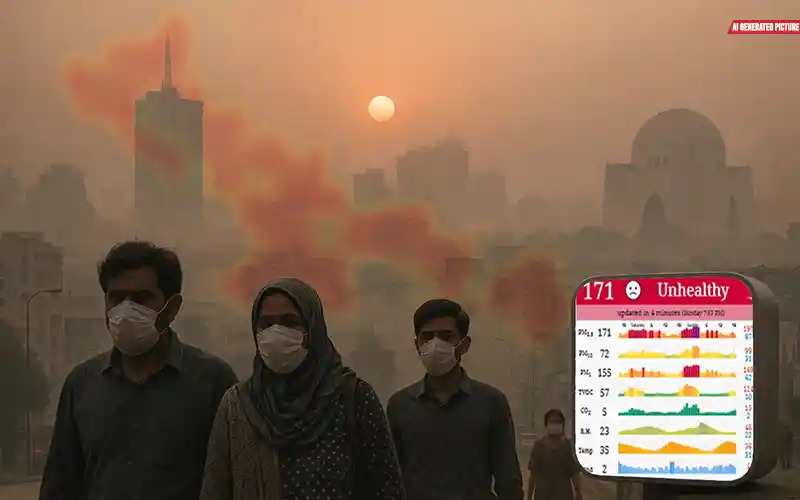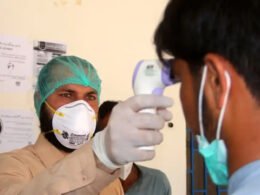The levels of air quality remained unhealthy in Karachi, raising serious health concerns, according to the latest air quality index report updated Sunday at 08:00 PM.
The latest air monitoring reports recorded PM2.5 concentrations ranging between 92 and 171 micrograms per cubic meter in different areas across Karachi.
The highest recorded PM2.5 level was 171 µg/m³ in Asif, Gulistan-e-Johar (Gulshan District), followed by 151 µg/m³ at DG House, DHA 5 (Saddar Town), and 142 µg/m³ at G3 Engineering Consultants in Karachi District.
Other locations with critically high readings included the Urban Resource Center, Jamshed Town (140 µg/m³) and Agha Khan University IED in Gulshan-e-Iqbal Town (145 µg/m³).
Moderately high pollution levels were observed at NED Main Campus (118 µg/m³), Aman Khan Kaka Khail in North Nazimabad Town (120 µg/m³), and University of Karachi’s Institute of Space Science and Technology (101 µg/m³).
Additional monitoring stations such as NED University City Campus (98 µg/m³), Climate Action Center and Urban Unit Karachi in Jamshed Town (both at 93 µg/m³), and Zafar Memon DHA (87 µg/m³) also reported unhealthy air quality.
To stay informed about current Karachi Air Quality, visit TOK Weather Page
These elevated PM2.5 levels are categorized as hazardous by international health standards and can cause respiratory and cardiovascular issues with prolonged exposure.
Health experts are urging citizens, especially those with preexisting health conditions, to take precautions such as wearing masks, limiting outdoor activity, and using air purifiers indoors.
How many categories are there to measure Air Quality?
AQI 0–50: Good
The air quality is considered excellent, with minimal or no risk to public health. There are no necessary precautions for the general population.
AQI 51–100: Moderate
Air quality is generally acceptable; however, there may be a slight health concern for a small number of individuals who are unusually sensitive to air pollution. Active children, adults, and people with respiratory conditions like asthma should consider limiting prolonged outdoor activity.
AQI 101–150: Unhealthy for Sensitive Groups
Sensitive individuals, such as those with asthma or other respiratory issues, may begin to experience health effects, although the general population is unlikely to be affected. It is advised that active children, adults, and those with respiratory conditions limit extended outdoor exertion.
AQI 151–200: Unhealthy
Health effects may begin to affect everyone, with sensitive groups potentially experiencing more serious symptoms. Active children and adults, and people with respiratory illnesses should avoid prolonged outdoor activity, while others—especially children—should reduce outdoor exertion.
AQI 201–300: Very Unhealthy
This range signals emergency-level health warnings. The entire population is more likely to experience adverse health effects. Those with respiratory conditions and active individuals should avoid all outdoor activity, while everyone else, particularly children, should limit time spent outdoors.
AQI 300+: Hazardous
Air quality is extremely poor, posing a serious risk to health for everyone. A health alert is in effect, and all outdoor exertion should be avoided by the entire population.










